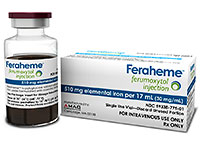Feraheme for iron deficiency anemia in CKD
COMPANY: AMAG
PHARMACOLOGIC CLASS: Hematinic
ACTIVE INGREDIENT: Elemental iron 30mg/mL (as ferumoxytol 510mg/17mL); colloidal iron for IV inj; contains mannitol 44mg/mL; preservative-free.
INDICATION: Iron deficiency anemia in adult patients with chronic kidney disease (CKD).
PHARMACOLOGY: Feraheme is a colloidal form of iron (superparamagnetic iron oxide coated with polyglucose sorbitol carboxymethylether) that is formulated with mannitol. The carbohydrate coating helps isolate the bioactive iron until the iron-carbohydrate complex enters the reticuloendothelial system macrophages in the liver, spleen, and bone marrow. After its release from the complex, the iron enters the intracellular iron storage pool (eg, ferritin), or is transferred to plasma transferrin for transport to erythroid precursor cells for incorporation into hemoglobin. Feraheme is not dialyzed.
CLINICAL TRIALS: Three randomized, open-label controlled clinical trials were conducted to assess the safety and efficacy of Feraheme for the episodic treatment of iron deficiency anemia in patients with chronic kidney disease. Patients were randomized to either oral iron therapy (ferrous fumarate 200mg iron/day for 21 days) or Feraheme (two 510mg injections). Trials 1 and 2 enrolled patients with CKD not on dialysis, and Trial 3 enrolled patients with CKD on hemodialysis. The changes in hemoglobin (g/dL) from baseline to day 35 in the three trials were 1.2, 0.8, and 1.0 for groups given the study drug, and 0.5, 0.2, and 0.5 for the oral iron therapy groups. Transferrin saturation and ferritin measurements also showed improvement for the Feraheme groups compared to the oral iron therapy groups. These trials also included an elective uncontrolled, follow-up phase in which patients with persistent iron deficiency anemia were given two additional 510mg injections of Feraheme. Overall, the majority of these patients (70%) experienced a further increase in hemoglobin, transferrin saturation, and ferritin. The mean change in hemoglobin level from the retreatment baseline for patients with an increase in hemoglobin was 0.86g/dL and was 0.5g/dL for all patients.
ADULTS: Give undiluted by IV injection at a rate up to 1mL/sec (30mg/sec). Initially 510mg, then an additional dose 3-8 days later. May repeat in persistent or recurrent iron deficiency anemia. Hemodialysis: give at least 1 hour after starting hemodialysis and after BP is stable.
CHILDREN: Not recommended.
CONTRAINDICATIONS: Iron overload. Anemia not due to iron deficiency.
PRECAUTIONS: Monitor for hypotension, and for hypersensitivity for at least 30 minutes after injection. Evaluate hemoglobin, ferritin, iron, transferrin saturation at least 1 month after 2nd injection. Have equipment/personnel available to treat hypersensitivity reactions. Pregnancy (Cat.C). Nursing mothers: not recommended.
INTERACTIONS: May transiently (up to 3 months) affect diagnostic ability of MRI (see literature).
ADVERSE REACTIONS: Diarrhea, nausea, hypotension, dizziness, constipation, peripheral edema; infusion reactions, hypersensitivity reactions (eg, rash, pruritus, urticaria, wheeze).
HOW SUPPLIED: Single-use vials (17mL)—1, 10
For more information call (877) 411-2510 or visit www.Feraheme.com.
